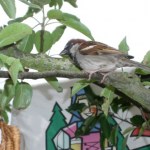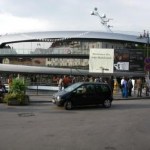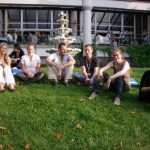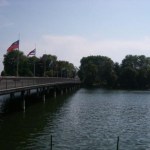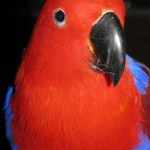
As we mentioned just the other day, studying animal behavior is tough as "animals do whatever they darned please". Thus, making sure that everything is controlled for in an experimental setup is of paramount importance. Furthermore, for the studies to be replicable in other labs, it is always a good idea for experimental setups to be standardized. Even that is often not enough. I do not have access to Science but you may all recall a paper from several years ago in which two labs tried to simultaneously perform exactly the same experiment in mice, using all the standard equipment, exactly…
A brief interview with one of the young researchers attending the Lindau Nobel conference - Jan Wedekind, formerly of University of Barcelona, Spain, and now with IRIS:
As I was traveling, I only briefly mentioned the brand new and exciting paleontology paper in PLoS ONE - New Mid-Cretaceous (Latest Albian) Dinosaurs from Winton, Queensland, Australia that was published on Thursday. Bex has written an introduction and will post a Media/Blog coverage (of which there was a lot!) summary probably tomorrow.
The fossils were discovered, cleaned and analyzed by the Australian Age Of Dinosaurs non-profit organization, with a help of thousands of volunteers - the 'citizen scientists'. You can learn more from their press release.
The importance of the publication of…
The island of Mainau has been designed, decades ago, as a gigantic garden, natural preserve, and a model of sustainability. Thus, animals roaming the island are exceptionally fearless of humans. For this picture, taken during lunch on the island, all I needed to do was extend my camera-hand, while sitting, until it was about two feet away from the bird:
All sorts of birds, from crows to peacocks roam freely among the throngs of tourists there.
A brief interview with one of the young researchers attending the Lindau Nobel conference - Fenja Schoepke of RWTH Aachen, Germany.
Friday was a special day at the Lindau Nobel conference. The official program was over but, instead of letting us all go home, the organizers did something better - a day trip on a boat to the island of Mainau where, while still under the influence of the proceedings, the participants had a chance to relax and walk and chat and enjoy the nature. What a great way to finish the event!
As the underlying theme of the meeting was the worry about Climate Change and sustainable development, it is quite fitting that the trip was on board of MS Sonnenkönigin, a solar-powered ship.
This was also an…
I wrote this post back on January 23, 2005. It explains how clock biologists think and how they design their experiments:
So, are you ready to do chronobiological research? If so, here are some of the tips - the thought process that goes into starting one's research in chronobiology.
First, you need to pick a question. Are you interested in doing science out of sheer curiosity to discover stuff that nobody knew before (a very noble, but hard-to-fund pursuit)? Or would you prefer your work to be applicable to human medicine or health policy, veterinary medicine, conservation biology, or…
A brief interview with one of the young people attending the Lindau Nobel conference - Anna-Maria Huber from the Lindau high school:
Two interesting papers came out last week [from the Archives - click on the clock logo to see the original post], both using transgenic mice to ask important questions about circadian organization in mammals. Interestingly, in both cases the gene inserted into the mouse was a human gene, though the method was different and the question was different:
Turning a Mouse Into A Lark
The first paper (Y. Xu, K.L. Toh, C.R. Jones, J.-Y. Shin, Y.-H. Fu, and L.J. PtáÄek
Modeling of a Human Circadian Mutation Yields Insights into Clock Regulation by PER2. Cell, Vol 128, 59-70, 12 January 2007) is…
Thursday morning was the Biofluorescence morning, with lectures by the three most recent Nobelists who received their prize for the discovery and first uses of the Green Fluorescent Protein (GFP) and its derivatives that glow in other colors. It's hard to think of an animal that is as non-model in the lab as jellyfish and a discovery as important and useful for modern biological research.
Unlike PZ who was a diligent liveblogger in the conference hall, I watched all three lectures from the press room, livestreamed on my laptop, while multitasking and generally enjoying the perks of being "…
Just trying to catch up with the publicartions in various PLoS Journals this past week. Here are some interesting titles.
As always, you should rate the articles, post notes and comments and send trackbacks when you blog about the papers. You can now also easily place articles on various social services (CiteULike, Mendeley, Connotea, Stumbleupon, Facebook and Digg) with just one click. Here are my own picks for the week - you go and look for your own favourites:
What a Plant Sounds Like: The Statistics of Vegetation Echoes as Received by Echolocating Bats:
More than 800 species of bats…
A brief interview with one of the young researchers attending the Lindau Nobel conference - Matthew Siebert of the University of California, Davis, USA:
This post is a modification from two papers written for two different classes in History of Science, back in 1995 and 1998. It is a part of a four-post series on Darwin and clocks. I first posted it here on December 02, 2004 and then again here on January 06, 2005:
II. Darwin on Time
There is a season for everything
And a time for every purpose under the heaven:
A time to be born, and a time to die:
A time to plant and a time to reap.... (Ecclesiastes)
In this section I will attempt to evaluate from Darwin's writings what he thought about the selective role of environmental periodicities…
No man was ever endowed with a right without being at the same time saddled with a responsibility.
- Gerald W. Johnson
This is going to be a challenging post to write for several reasons. How do I explain that a paper that does not show too much new stuff is actually a seminal paper? How do I condense a 12-page Cell paper describing a gazillion experiments without spending too much time on details of each experiment (as much as I'd love to do exactly that)? How do I review it calmly and critically without gushing all over it and waxing poetically about its authors? How do I put it in proper theoretical and historical perspective without unnecessarily insulting someone? I'll give it a try and we'll see…
The series of interviews with some of the participants of the 2008 Science Blogging Conference was quite popular, so I decided to do the same thing again this year, posting interviews with some of the people who attended ScienceOnline'09 back in January.
Today, I asked my SciBling GrrrlScientist of the Living the Scientific Life blog to answer a few questions.
Welcome to A Blog Around The Clock. Would you, please, tell my readers a little bit more about yourself? Who are you? What is your (scientific) background?
I write the blog, Living the Scientific Life (Scientist, Interrupted), under…
This post about the origin, evolution and adaptive fucntion of biological clocks originated as a paper for a class, in 1999 I believe. I reprinted it here in December 2004, as a third part of a four-part post. Later, I reposted it here.
III. Whence Clocks?
Origin, Evolution, and Adaptive Function of Biological Clocks
The old saw about the early bird just goes to show that the worm should have stayed in bed. (Heinlein 1973)
Now darkness falls.
Quail chirps.
What use Hawk eyes?
(Basho)
Local/temporary and global/universal environments. In the study of adaptive functions, usually the question…
